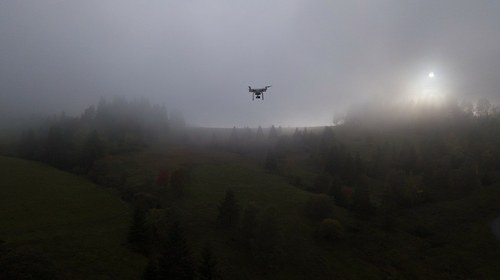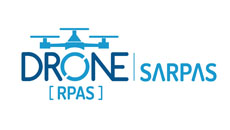Drones and Meteorology
Topics available on this page:
- RPA flight in bad weather conditions
- Rain
- Wind gusts and wind shear
- Danger of wind in areas with obstacles
- Fog
- Loss of eye contact with RPA
- Night flight
- Flight Planning
RPA flight in bad weather conditions
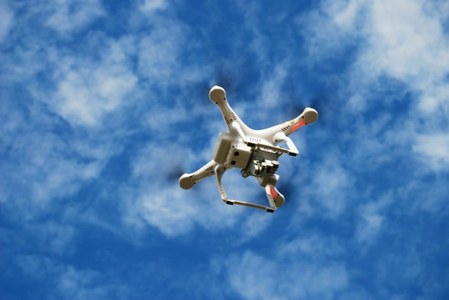
Photo: Freepik
The purpose of this guidance material is to emphasize the importance of preserving an acceptable level of safety of persons and property of third parties during operations of drone under specific meteorological conditions that may be adverse to flight.
As it is known, the group of meteorological adverse phenomena for flight more relevant present variations according to technical and operational characteristics.
Although there are drones that weigh more than 1 tonne and can fly above 60,000 feet, most operations involve small aircraft flying close to the ground and thus are more vulnerable to adverse weather conditions that occur at low altitudes.
DOC - 1009 - Manual on Remotely Piloted Aircraft Systems (PSURs) (ICAO) (in English)
RPA sensitive to hazardous meteorological conditions
14.4.7 Small RPA may be more sensitive to hazardous meteorological conditions due to Their low and MTOM, More specifically, the wing / power loading of the aircraft.
This guidance material is geared specifically for remote pilots operating equipment up to 25 kg up to 400 feet above ground level.
Before commencing a flight, in addition to knowing the operating manual of the equipment, the remote pilot must be aware of all the information necessary for the flight planning.
One of the necessary information for the flight is the careful evaluation of the weather conditions.
Weather conditions are ideal for safe drone operation. Sunny days with calm or weak wind offer less risk to the safety of the operations of this type of equipment.
However, it may be necessary to operate a RPAS in weather conditions that do not always fit the ideal operating profile. In this situation, care must be taken not to compromise the safety of the operation and to avoid damaging the equipment and, in particular, the risk of collision with objects, persons and aircraft.
DOC - 1009 - Manual on Remotely Piloted Aircraft Systems (PSURs) (ICAO) ( in English )
08/04/41 The RPAS instructor shouldnt ENSURE that the applicant for the remote pilot license has operational experience in The Following areas to the level of performance required for the remote pilot, if applicable:
i) identification of hazardous meteorological conditions and avoidance procedures thereof;
In case of operation in low temperature conditions or under strong winds, a loss of charge of the equipment battery can be verified more quickly. On the other hand, high temperatures can lead to wear of the battery and electronic components of the equipment.
To avoid RPA flight in adverse weather conditions, it is recommended that the remote pilot is aware of pre-flight weather information and knows the risks that certain phenomena may offer for this type of operation. Such care will help increase your situational awareness.
In addition, the remote pilot must know the operational limits of the equipment as regards the weather conditions. Wind speed above 20 kt, snow, rain and fog are adverse weather conditions for the operation of some models, such as Phantom 4 and Mavic .
DOC - 1009 - Manual on Remotely Piloted Aircraft Systems (PSURs) (ICAO) ( in English )
10.7.4 The remote pilot's situational awareness of what is happening in the vicinity of the RPA helps him understand how other information, events and his own actions will impact the goal of avoiding each hazard. The remote pilot's awareness may develop throughout the three phases of the conflict management approach:
a) during the strategic conflict management phase, the following elements help develop awareness:
1) flight planning;
2) NOTAMs;
3) meteorological information ;
Operating environment;
5) other relevant information;
b) during the separation provision or RWC phase, the following elements help maintain awareness:
1) on-board equipment (surveillance information, DAA RWC information, airborne collision avoidance system (ACAS), terrain awareness warning system (TAWS), etc.) ;
2) ATC;
3) meteorological information;
4) general flight conditions; and
c) during the CA phase the situational awareness of the pilot may be affected by alerts from a DAA system or ATC.
Rain
The rains are formed by drops of water with a diameter of more than 0.5 mm visibly separated that fall from the clouds. They are usually caused by the encounter between two air masses (a mass of cold air and a mass of warm air), due to a front or an elevation of a cloud by ascending currents.
Flying during rainfall can cause equipment to be destroyed because most drones are not waterproof or waterproof. Rainwater, even in light rainfall conditions, can come in contact with hot batteries and motors and cause breakdowns in electronic systems.
In addition, this weather condition may cause greater difficulty for operation of drones that use cameras for stability and navigation, as rain can reduce the contrast required for the camera to discern movement.
Rainwater action can degrade control and control link performance and can result in a significant reduction in radio range. In addition, excess moisture can cause temporary equipment failure.
Another danger that can be encountered during the operation of a RPAS under rainfall condition is the difficulty of viewing the drone either by a remote observer / pilot - something critical in VLOS operations - or by another aircraft. Rainwater can also greatly reduce the view of the front camera - on aircraft equipped with this equipment.
If rain starts during operation, it is highly recommended to stop the flight and dry any parts of the equipment that are wet.
One way to avoid the risk of rains for drone flight is to check available weather information before starting the operation and review the latest weather reports and weather forecasts. Such planning requires adequate anticipation of the take-off time of the equipment.
Wind gusts and wind shear
The winds become strong whenever there is a large pressure difference between two points. In this situation, the air will move from the point of greatest pressure to the point of least pressure in the horizontal direction.
In regions where stronger winds are frequent, drone flight can become potentially dangerous, because under wind and wind shear conditions, correcting RPA piloting may not be sufficient to ensure safe operation.
Each RPA has a strong wind tolerance, which is reported by the manufacturer. Flying outside the tolerance limits can cause navigation problems as the equipment may not have the strength to overcome wind resistance or can acquire extreme speeds very quickly.
If the wind speed exceeds 15kt (32 km / h), the remote pilot may experience difficulties in controlling the navigation of the equipment, which could lead to a risk of collision with people, aircraft or obstacles.
Above this speed, the resistance level of the equipment to the effects of the wind will vary according to the size of the propellers, motor spin and equipment weight. A drone like Phantom 3 should not fly with winds above 36 km / h. Have a higher drone as a 6SGEO of Mikrokopter can fly in windy conditions up to 49 km / h.
It is possible to use speed measurement sensors that can be installed on fixed-wing drones. In the case of multidrive drones, the installation of these sensors becomes a little more difficult, since the sensor must be fixed in a place that is not influenced by the wind of the drone propellers themselves.
Performing drone operation in high wind conditions requires a lot of practice, patience, and concern about battery charge replenishment.
This is the case, for example, when the remote pilot decides to fly at a height higher than allowed by the equipment manual. In this situation, the RPA may face difficulties to overcome wind resistance. It is important to note that at higher levels, the wind speed can vary more rapidly due to the decrease in atmospheric pressure, which requires greater care with the parameter wind speed during the operation.
Another potentially dangerous situation is operation under the effect of lateral wind - when the wind is in the direction towards the side of the RPA.
If the side wind is at high speed, the remote pilot may be surprised. In this situation, the equipment can exit its line of sight and lose the signal of the radio, entering FailSafe mode. If the height set for the return is not sufficient, the equipment may collide with vegetation or with obstacles in the ground.
Side winds are common in overflight of mountainous areas, mainly in the region of the exit of the mountains.
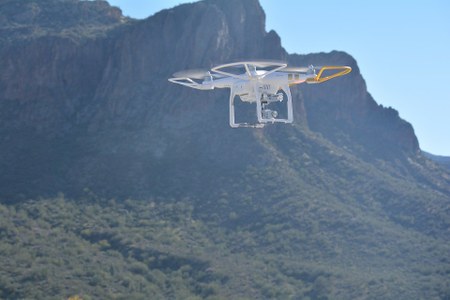
Photo: Pixbay
Another care the remote pilot needs to have in relation to the wind is to know his direction before starting the operation of the RPA so that the planning of the operation is compatible with the battery life of the equipment.
If the operation is started in favor of the direction of the wind and the flight of the return stretch to the base is carried out against the direction of the wind, there will certainly be greater use of the battery in the return section. This detail must be taken into account when planning the operation.
It is also essential that the remote pilot knows all the limits of autonomy of his equipment to avoid descents with very high speed, which can potentiate the wind gradient and cause risk of collision with ground, obstacles and people.
To mitigate the danger of gusting winds, side winds or wind shear during RPA operation, it is critical to consider wind data to the surface during the planning of the flight. There are web pages that bring the information in real time and the tendency for the next hours of direction and the speed of the wind on the surface.
https://www.climatempo.com.br/vento/
Danger of wind in areas with obstacles
If the operation is carried out near areas that have large buildings, artificial shelters or natural obstructions, such as large trees, it is necessary to have extra attention. Obstacles in the soil affect the flow of wind. For this reason, it is recommended, before starting the operation in these places, to know the different wind patterns of the locality.
Fog
The remote RPAS pilot should give preference to Visual Line of Sight (VLOS ) operations, in which the pilot maintains eye contact with the RPAS throughout the flight.
Visibility restrictions may prevent the remote pilot from maintaining direct eye contact with the RPA.
Loss of eye contact with RPA
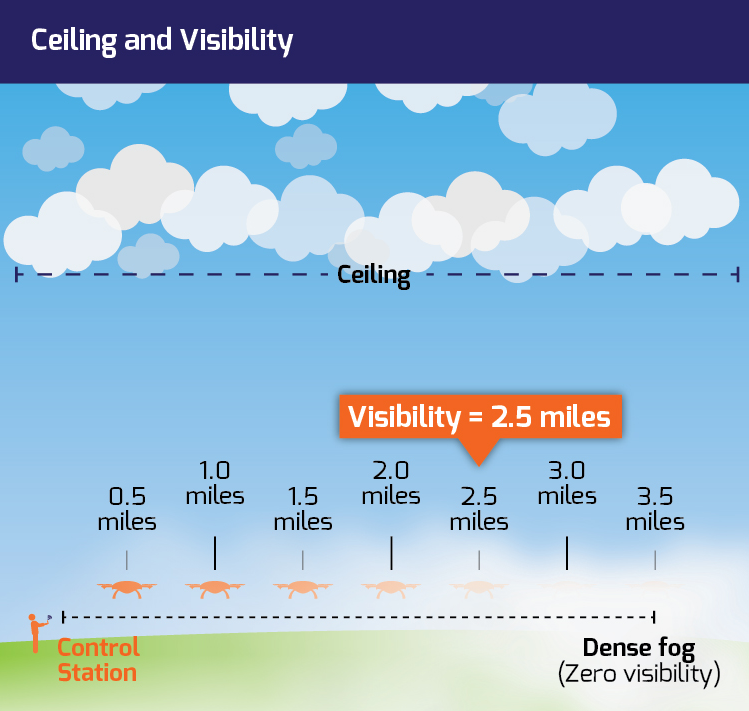
In this situation, a VLOS operation can turn into an EVLOS operation, where the remote pilot will need help from lenses, other equipment and from RPA observers to safely conduct flight, avoiding aircraft collisions and obstacles.
If the visibility restriction becomes more intense due to the fog phenomenon, the remote pilot must follow the requirements applied to the pilots of the manned aircraft, regarding the instrument flight rules (IFR) stipulated in ICA 100-12 - Rules of the Air .
To avoid unexpected entry into instrument flight conditions (IFR), the remote pilot must be aware of the visibility minima and not perform the operation under a fog condition.
Fog is a phenomenon whose physical constitution resembles that of a cloud, differing only in location because it occurs near the surface. It is formed by extremely small water droplets that float in the air, reducing the horizontal visibility to less than 1 thousand meters.

Photo: Pixabay
Formation occurs when the air temperature is low enough to render the water vapor liquid. For this to occur, it is necessary that the environment is very humid, with large amount of droplets of water suspended in the air.
When flying in mountainous regions, the remote pilot should be aware of the sudden reduction of visibility, since the altitude acts in the reduction of temperatures and in the interception of the masses of humid air coming from other localities, which increases the probability of occurrence of fog. The same care should be taken in the case of overflight of areas close to watercourses, such as rivers and especially lakes, because during the day there is the emission of large amount of moisture in the form of vapor, which condenses during the night, forming denser fogs in the wee hours of the morning.
In the vertical direction, the fog causes reduction of visibility, being able, in some occasions, totally obscure the sky.
Favorable conditions for fog formation are weak surface winds, high relative humidity (close to or equal to 100%) and abundant condensation cores.
If the remote pilot decides to operate the equipment after the fog has dissipated, it should increase its attention. During the dissipation of a fog, although the conditions of visibility in the ground improve, often a thick layer of clouds is formed covering the whole sky, whose base can be between 50 and 100 meters of the ground. This weather condition can impair VLOS operations, in which the pilot must maintain eye contact with the RPAS throughout the flight.
In some situations of occurrence of stationary front, the presence of fog and cloudiness that restricts visibility can be verified in the post-frontal area.
In the flight planning phase, it is possible to obtain information on the probability of occurrence of fog at the place where the flight will be carried out, by consulting meteorological bulletins.
Night flight
The absence of daylight can impair the maintenance of the VLOS (Visual Line of Sight condition , in which the RPA remains in the pilot's field of vision). Because of this, DECEA recommends that the RPA remote operator give preference to operations while there is daylight, avoiding flights during the night.
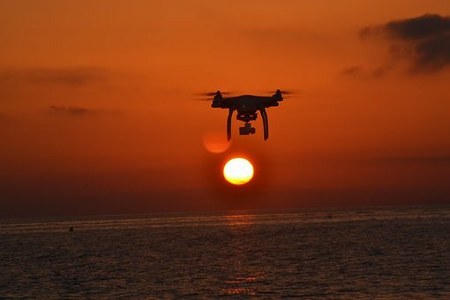
Photo: Pixbay
If the operation is performed at night, it must comply with the conditions set forth in the Instruction of the Aeronautics Command that deals with Air Rules (ICA 100-12), item 4.2.4.
Link to ICA 100-12 https://publicacoes.decea.gov.br/?i=publicacao&id=4429
DOC - 1009 - Manual on Remotely Piloted Aircraft Systems (RPAS) (ICAO )
10.14 MITIGATING THE RISK OF HAZARDOUS METEOROLOGICAL CONDITIONS
10.14.1 All aircraft are affected by meteorological conditions. In manned aviation, the pilot is able to monitor changes to the conditions visually and through the use of sensors and the display of their information. Remote pilots conducting BVLOS operations must rely to a great extent on sensors and the display of sensor information.
Flight Planning
Making a pre-flight weather checklist can be a great way to ensure a safe flight to the equipment, avoiding the risk of collision with objects, people, and aircraft. Before starting the operation, consult the weather information of the operation site and nearby regions.
It is recommended to observe the following sequence of checks:
|
|
Consult METAR, SPECI, TAF, checking the conditions of wind, visibility, ceiling, cloudiness, temperatures and precipitation; |
|
|
Check for warnings of expected adverse weather conditions (ice formation, fog, heavy rain, wind shear etc.) |
DOC - 1009 - Manual on Remotely Piloted Aircraft Systems (PSURs) (ICAO) (in English)
9.4 ENVIRONMENTAL CONSIDERATIONS
Meteorological conditions - consistent with performance limitations
9.4.1 The remote pilot shouldnt review all available meteorological information pertaining to the operation and performance limitations of the RPAS. Particular attention should be given to such conditions as:
a) surface visibility;
b) wind direction / speed;
c) hazardous meteorological conditions including cumulonimbus, icing and turbulence; and
d) upper air temperature.
9.4.2 Flight into or known icing conditions should not be carried out unless the system is certificated and equipped for such conditions, with the icing protection systems operational in accordance with the MEL, and the remote pilot is current in, and qualified for, cold weather operations.
It is possible to complement the meteorological information provided by the official agencies (DECEA, INMET, CPTEC etc.), using images from live cameras and meteorological station bulletins, through the following electronic addresses:
- https://www.redemet.aer.mil.br/
- http://www.climaaovivo.com.br/
- http://www.camerasdotempo.com.br/
- http://www.chuvaonline.iag.usp.br/
- http://estacoes.charlier.com.br/
- https://earth.nullschool.net/#2014/05/24/1800Z/wind/isobaric/500hPa/equirectangular=-51.72,-14.47,862
- https://www.cgesp.org/v3/
- https://www.windy.com/?-23.573,-46,642.5
- http://www.cemaden.gov.br/
- https://www.skylinewebcams.com/
- https://www.climatempo.com.br/vento/
DOC - 1009 - Manual on Remotely Piloted Aircraft Systems (PSURs) (ICAO) (in English)
Take-off and landing phases
14.2.5 RPAS may be operated in either VMC or IMC, and the associated VFR and IFR restrictions applicable to manned aircraft will apply. These operations may also be conducted within VLOS or BVLOS depending on the capability of the RPAS involved. Of particular note is the requirement for the RPAS operator to be able to determine the meteorological conditions in which the RPA is operating during these phases, in order to ensure the RPA is indeed operating in accordance with applicable flight rules.
VFR
14.2.7 The remote pilot or RPAS operator must be able to assess the meteorological conditions throughout the flight. In the event the RPA, on a VFR flight, IMC encounters, appropriate action must be taken.
The FAA reported in FAA Safety Briefing - November / December 2017 that it is possible to complement the flight planning of a RPAS with the use of flight simulation applications. Simulation allows you to create scenarios such as mechanical failures and connection problems and simulate adverse weather conditions to which the equipment will be subjected. With this, you can pre-program commands or waypoints in advance and see how equipment will respond in different weather conditions, landscapes, and scenarios.
https://www.faa.gov/news/safety_briefing/2017/media/NovDec2017.pdf
To consult the DECEA regulations and obtain other information necessary to make safe flights, as well as obtaining authorization to access Brazilian airspace, access the SARPAS - Remotely Accessed Aircraft Access Request (RPAS)
Further information regarding the operation of drones can also be found on the drones page and on the DECEA page.
If doubts remain, you can consult the Manual of Guidelines for drones users or contact the Contact the Administrator or the telemarketing call center 163 .
**Notes containing items of Brazilian regulations have not been translated so that their interpretation is not different from the intended interpretation.
Did you find errors in this content ? Send email to meteorologia@anac.gov.br to report.

